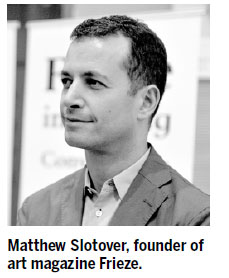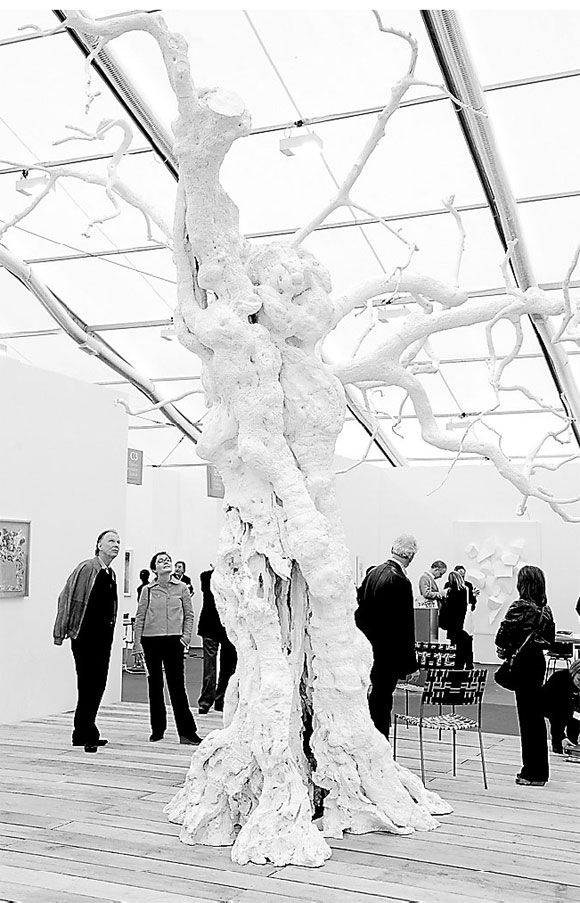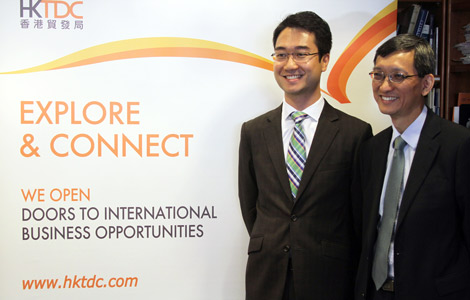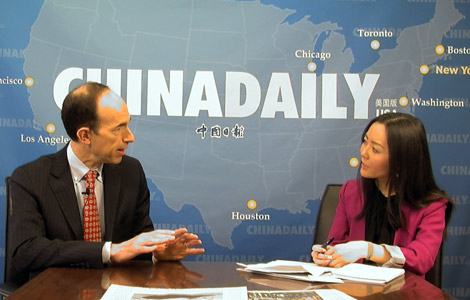Flying Frieze
Updated: 2014-09-16 09:10
By Lin Qi(China Daily USA)
|
||||||||
An art magazine that holds shows in New York and London courts artists and collectors in China with the hope of doing the same here, someday. Lin Qi reports.
Matthew Slotover couldn't conceal his weariness due to jet lag on an evening in August. The founder of the London-based art magazine Frieze was attending a party hosted by Zhang Rui, a Beijing businessman and art collector, at his villa in northern Beijing.
Zhang and his wife had shown Slotover around their house, which has a big collection of art, mostly contemporary Chinese works. The paintings, sculptures, installations and videos decorate almost every corner including toilets and the ceiling.
Slotover, 46, came to Beijing on a weeklong visit. He went to the Central Academy of Fine Arts to meet artists, critics and curators such as Xu Bing and Philip Tinari.
He also stopped at the 798 and Caochangdi art zones, as well as contemporary artist Zeng Fanzhi's studio where they talked about a new museum that Zeng seeks to open. In 2012, Zeng created Yuan Space in a high-rise building in the city's Guomao locality.
Slotover also talked to some Shanghai artists and gallerists. His China connection dates back at least 10 years, when he first came to Beijing.

Since then, Chinese galleries such as the Long March Space and ShanghART, have participated in the Frieze art fairs in London and New York. The Frieze magazine also has contributing editors and writers based in China.
But this time around, Slotover claimed it was on his first official trip representing Frieze in the world's second-largest art market. Speaking to China Daily on Aug 31, Slotover said, it felt "like a good time" as more Chinese collectors showed interest in buying international art.
"In the past, Chinese collectors bought Chinese art ... They were not so much buying international art. It didn't make so much sense to inform them about Frieze because it was a bit early for them," he says.
But with the rise in recent years of a younger generation of Chinese collectors, who are educated and well-traveled, a greater interest in what's going on in the international art scene has been generated.
Chinese gallerists told Solotover at Frieze's recent fairs in New York and London that although there weren't many Chinese collectors at one of the magazine's fair last year, the few participants were "super smart and open" in their artistic judgment.
"So it's a good time for us to meet them and explain what we do, and encourage more of them to come to Frieze. We have fairs in London and New York, both fantastic cities that Chinese have known well and enjoy traveling to," Slotover says.
"It is a trip for us to research more in China. ...there are always new galleries up and coming. We are also looking for new artists for magazines and who could be invited to the fairs. Really we want to increase the dialogue."
The visit has raised questions about the possibility of Frieze art fair staging a Chinese version. Slotover says the right time has yet to come.
"People have made suggestions that why don't you come to Beijing and Shanghai. But we know it's complicated and we're not ready for that yet," he says. Art Basel, the only international art fair to have a presence in China, made its debut with a show in Hong Kong in 2013.
"I know they are having some successes and also some difficulties," Slotover says.
The Maastricht-based European Fine Art Fair failed in its bid to enter the mainland market last year.
It had hoped to develop a high-end fair in Beijing via a Sotheby's joint venture with the State-owned Beijing GeHua Art Company. But it canceled the proposal in December and explained in a statement that "the market for many of the specializations represented at Maastricht is still evolving" on the mainland, and the majority of dealers attending the fair would consider exhibiting on the mainland "at a later date".
"It's not easy for international galleries to come (to the mainland) to sell art. The taxes are very high, for instance," Slotover says.
He adds however that if enough reputed global galleries say that they will come, Frieze might think about even holding an art fair in China.
For about five years, galleries kept asking Frieze to get them shows in New York, and that was how its New York fair was born. At present, it is more viable to attract people to New York and London than to Asia.
But Slotover says that he has found a more workable way to strengthen ties with the Chinese market. Frieze has opened accounts on Chinese micro-blogging sites Sina Weibo and WeChat, where the magazine's events are promoted and some of its writings are translated into Chinese.
Contact the writer at linqi@chinadaily.com.cn
|
Visitors at the Frieze Art Fair in London in 2009. Photos Provided to China Daily |
(China Daily USA 09/16/2014 page9)

 Star Stefanie Sun holds concert in Beijing
Star Stefanie Sun holds concert in Beijing
 Faye Wong's manager refutes star's drug rumors
Faye Wong's manager refutes star's drug rumors
 Lu Yi and daughter Bei Er pose for street snaps
Lu Yi and daughter Bei Er pose for street snaps
 Photoshoots of actress Li Xiaomeng
Photoshoots of actress Li Xiaomeng
 Council of Fashion Designers of America Awards
Council of Fashion Designers of America Awards
 Fan Bingbing, first Chinese actress in Barbie Hall of Fame
Fan Bingbing, first Chinese actress in Barbie Hall of Fame
 Awarding ceremony of 2014 hito Pop Music held in Taipei
Awarding ceremony of 2014 hito Pop Music held in Taipei
 Zhao Liying's photo shoot for Children's Day
Zhao Liying's photo shoot for Children's Day
Most Viewed
Editor's Picks

|

|

|

|

|

|
Today's Top News
Improved quality 'key to growth', says Li
IMF assesses risks and benefits of shadow banking
Apple Pay eyes inroads to China
Sinopec privatization biggest in Xi's tenure
Beijing to tighten foreign hiring requirements
Hillary Clinton takes a big step toward 2016
US teachers visit China on fellowship
More CFAs buoy hopes for finance
US Weekly

|

|









